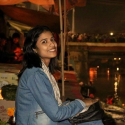The Masks of Nepal
Nepal is rich in hand craved wooden materials. Mask is one of them. There are various categories of mask found in Nepal according to different culture and religion. The main types are listed below:
- Ethnic
- Folk
- Cultural
- Religious
- Deity
- Demons
- Ghosts
- Shaman
- Ritual
- Exorcist
- Bhairav
Table of Contents
- 1 - Ethnicity, Mask Possession, and Mask Dances
- 2 - Typology of NEPALI MASKS
- 3 - Aesthetic Of Nepali Masks
- 4 - The Masks of God Mahakala of Tantric Buddhism
- 5 - Masks of Gods Shiva Indra Varahi
- 6 - Masks of Bhairab
- 7 - Mask of Navadurga
- 8 - Tiger Lion Mask
- 9 - Newar Masks Gorgon Lakhe
- 10 - Masks of Hanuman
- 11 - Mask of Ten-headed Ravana
- 12 - Pig mask from Tarai
- 13 - Monkey mask from Tarai
- 14 - Gurung Masks
- 15 - Magar Masks
- 16 - Thakali Mask Western Mid Himalaya
- 17 - Demons and Ghosts Middle Hills
- 18 - Ghost Local demons Demons and Ghosts
Ethnicity, Mask Possession, and Mask Dances
The Spatial Distribution of Ethnic Communities in Nepal is Gurung, Pahadi Castes Brahmin, Kshatriya, and Dalit, Kiranti, Rai, Limbu Newar Other Castes Tamang Bhotia, Sherpa, Thakali etc
- The ethnic and caste groups who developed the culture of the mask were the agrarian groups. They include Newar, Magar, Gurung, Rai, Limbu, Sherpa and other Himalayan people of Tibetan origin
- Tharu and other Tarai communities
- Shaman practitioners of all ethnic groups
- Hindus, Buddhists, and folk religious groups
- Tantric, Exorcists and other practitioners
There are various festivals related to mask according to ethnicity and culture. Various kinds of Hindu and Buddhist mask dances are performed as part of religion. The rules of ritual are strictly followed. Ethnic mask dances, which are rich in content and spectacular. Demonic masks are used in various folk dances and open-air theater.
Typology of NEPALI MASKS
- Religious Masks
- Folk Masks
- Deity Masks
- Ethnic Masks
- Cultural Masks
- Dance Drama Masks
- Exorcist Masks
- Festival Masks
- Ritual Masks
- Shaman Masks
Aesthetic Of Nepali Masks
The Mask Properties Masks are made of Metal [ Brass, Copper, Iron ] Terracotta Wood Paper Leaves Cloth Straw Paint. Some of the properties of Nepali Masks are listed below:
- The very rich tradition of ‘Mask culture and heritage.
- Several hundred types of masks exist.
- Lively cultural roles and religious as well as folk significance.
- Ethnic diversity led to developing varied forms of masks with diverse features.
- Most ethnic groups have indigenous masks culture, which they perform in specified days round the year.
- Nepali masks are religious, folk, cultural, festival, Shaman, an exorcist.
- Ethnic features are visible in designs and expressions.
- Masks are colorful or without color or one color mostly black.
- Masks reflect the worldview and identity of the group.
- Used in festivals, ceremonies, worship, practices etc.
- Spectacular with profound iconography, pattern, expression, and the role assigned so far.
- Patterns and performances reflect the cultural uniqueness and ethnic identity.
The Masks of God Mahakala of Tantric Buddhism
Masks of Gods Shiva Indra Varahi
Masks of Bhairab
Mask of Navadurga
Tiger Lion Mask
Newar Masks Gorgon Lakhe
Masks of Hanuman
Mask of Ten-headed Ravana
Pig mask from Tarai
Monkey mask from Tarai
Gurung Masks
Magar Masks
Thakali Mask Western Mid Himalaya
Demons and Ghosts Middle Hills
Ghost Local demons Demons and Ghosts























